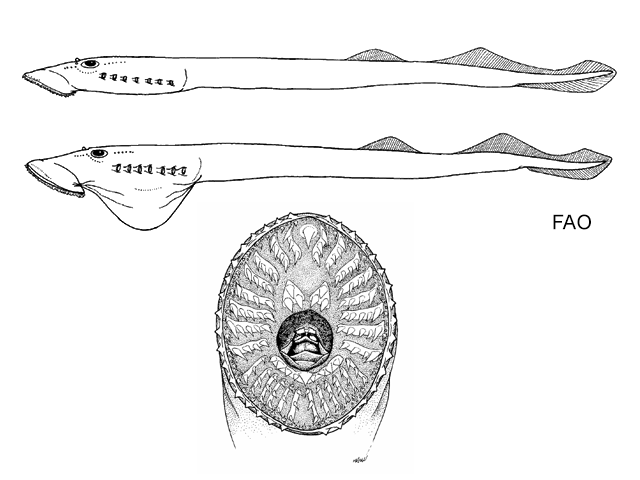| Mordaciidae (Southern topeyed lampreys) |
| 54 cm TL (male/unsexed) |
|
demersal; freshwater; brackish; marine, anadromous |
| Southeast Pacific: Rivers of southern Chile. |
|
Adult: 11.1-54.0 cm TL; body proportions, as percentage of TL (based on 39 specimens measuring 11.1-31.3 cm TL): 8.0-17.0 prebranchial length, 8.3-12.1 branchial length, 57.8-77.1 trunk length and 13.8-19.0 tail length. Mature males with large gular pouch that extends from immediately posterior of oral disc to end of branchial region; trunk myomeres, 78-84; dentition: supraoral lamina, 2 triangular supraoral laminae each with three unicuspid teeth, one per apex; infraoral lamina, 9-13 unicuspid teeth of various size in immature individuals and divided into 3 tricuspid plates with, in each case, the median cusp largest in spawning individuals; 7 endolateral plates on either side each bearing 3-5 unicuspid teeth (in prespawning individuals, usually 4-5); endolateral formula, typically 3-3-4-4-4-4-3 or 4-4-4-5-5-4-3 or 5 endolaterals as individual unicuspid teeth on either side in spawning individuals; 1-2 rows of anterials; first row of anterials consisting of 4 tricuspid radial plates in recently transformed individuals, of 2 tricuspid flanked on either side by 1 quadricuspid radial plate in feeding phase individuals and of 6 unicuspid teeth in spawning individuals; 1 row of exolaterals on each side; 1 row of posterials; first row of posterials, 10-12 tricuspid (sometimes quadricuspid) plates in prespawning individuals and 12 unicuspid teeth in spawning individuals; transverse lingual lamina, w-shaped, with numerous unicuspid teeth in prespawning individuals and with only 2 greatly enlarged lateral unicuspid teeth in spawning individuals; longitudinal lingual laminae, each with 9-15 unicuspid teeth; presence of caudal fin pigmentation but extent of coverage not determined; caudal fin shape, spade-like (Ref. 89241). |
| Ammocoetes and adults found in rivers. Ammocoetes occur in substrates of fine sand with abundant organic detritus along the river banks. Metamorphosis occurs between August and March and recently metamorphosed adults enter marine waters during austral winter (June-August) at about 14.3 cm TL. Anadromous. Adults parasitic on fishes in marine waters. Mature adults occur in continental marine waters between September and December (Ref. 89241). |
|
Vulnerable (VU); Date assessed: 22 March 2021 (A3cde+4cde) Ref. (130435)
|
|
Source and more info: www.fishbase.org. For personal, classroom, and other internal use only. Not for publication.

